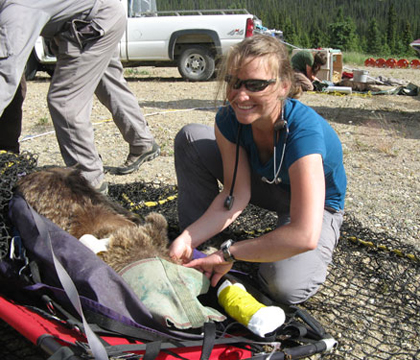
Keeping an eye on wildlife health in Yukon
A veterinarian, to most people, means someone with a white lab coat and a stethoscope treating pets in a clinic, or pulling calves on a farm in the middle of the night.
By WCVM TodayBut Jane Harms, the new program veterinarian with Environment Yukon, is more likely to find herself checking the health status of caribou or grizzlies.
"It's becoming much more common to have veterinarians working in positions associated with public health and wildlife health, outside of traditional clinical medicine," Harms explains.
She's part of the three-member Animal Health Unit at Environment Yukon, where her job involves monitoring wildlife health and disease as well as working with the Agriculture Branch to support livestock health.
"We're unique in that we're based in the Department of Environment and closely affiliated with wildlife managers and conservation officers, and also with public health. But we also have a responsibility for supporting the livestock industry and making sure we have healthy domestic animals."
Dr. Jane Harms recently received the W. Garfield Weston Award for Northern Research (Doctorate). Read more about her latest award.
In the Yukon, where livestock numbers are low compared to southern areas of Canada, "it's still very important to monitor the health of both livestock and wildlife populations so that we can keep a pretty close eye on whether germs, or pathogens, are being passed between those two groups."
Because wild ungulates (moose, elk, sheep, and caribou) and carnivores in the Yukon can live in close proximity to livestock, it's important to minimize any chances of livestock diseases getting transferred into wildlife, especially groups of animals that have no exposure to that particular illness. "You can see some pretty serious disease issues in wildlife populations because they don't have any immunity."
Such outbreaks can have consequences for people, too. Last month an anthrax outbreak in the Mackenzie Bison Sanctuary near Fort Providence, NWT, killed 400 wood bison out of a herd of about 1,400. "A massive outbreak like that in a key herd in a threatened species in Canada affects the people who live in and around the community and the people who harvest those animals," says Harms. "It's probably going to affect hunting regulations, too."
The bacteria that causes anthrax is concentrated in certain areas in the north and was probably brought by humans over the Beringian land bridge thousands of years ago. In the form of spores, the bacteria can last up to 10 years or more in the soil.
"There are high concentrations of the spores around the places in NWT where the wood bison are," Harms explains. "When conditions are right, the bison become exposed to the spores and there's an anthrax outbreak." The scavenging of a dead bison by birds and other wildlife releases the bacteria found in the bison's bloodstream, which then form spores, enabling the cycle of infection to continue.
What about the wood bison that were brought into the Yukon starting in the late 1980s? Since most bison die of anthrax if they are infected with it, testing for previous exposure to the disease is not really done. "And the bison that formed the Yukon herd were mainly from other herds that had not had anthrax outbreaks, although they might still have been exposed to anthrax when they were in those source herds."
Yukon's wood bison were from a herd that was free of the most serious diseases, which would be tuberculosis (TB) and brucellosis, says Harms – diseases that, unlike anthrax, can be carried by other members of the herd.
She's hoping to do some surveillance and monitoring of bison health here. "We'll do some testing to confirm that they're still free of those diseases and some others, and to see if we find any changes in exposure."
Different strains of brucellosis can be found in other ungulates, especially caribou, while tuberculosis can occur in elk and deer. TB and brucellosis are also both diseases of domestic cattle (which is where the diseases in some wild bison herds originated, though Canadian cattle are currently disease-free) and of humans.
"In a place like Yukon, where many people harvest wildlife and eat game, it's important to know what kinds of germs are circulating in wildlife populations," says Harms. Brucellosis, for example, can be transmitted in butchering or eating a caribou – "if you cut through an infected area of the animal and then cut yourself, or if you eat a large amount of the bacteria."
That's why, although disease levels in Yukon wildlife are low, monitoring and surveillance for such disease is so important. "It gives us a baseline of what's here and whether we have a disease or pathogen and if so, where does it come from, and has it been moved in?"
Harms also works with biologists and wildlife managers in BC, NWT, and Alaska where wildlife populations overlap. "We're one of the last frontiers where we have huge wild spaces and healthy populations of wildlife," says Harms.
"So it's very important to monitor the health of both the livestock we have here and the wildlife populations so that we can keep a pretty close eye on whether there's any pathogen transfer between those two groups. That way we have a good handle on what's happening so both can prosper."
Reposted with permission from yourYukon. yourYukon is co-ordinated by the Yukon Research Centre at Yukon College with support from a group of Yukon-based sponsors.
